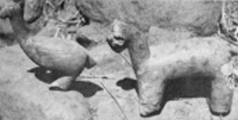| |
| |
- Mbudzi na nngwe - THE GOAT AND THE LEAOPARD
- (Mbudzi i
 tshitumbani - THE GOAT WILL GO INTO THE PEN) tshitumbani - THE GOAT WILL GO INTO THE PEN)
-
- The master at Thengwe insisted that this show was the second part of a 'lesson' (pfunzo), the only 'lesson' of domba, which began with iron-working and hoeing a river garden. He intended to do it during the following week, but he postponed it two of three times and eventually forgot all about it. Thus, I never saw the show, and I have only descriptions of it and the milayo.
-
-
|

Wooden model of a hammerhead and a leopard. The leopard's spots are just visible. |
Stayt (1931 :121-22) describes a sequence of events which was not apparently done in the areas that I visited, but which followed the general pattern whereby a clay or wooded model of a goat is 'attacked and killed' by a model of a leopard. The novices are reminded to take care of their livestock and to give them adequate protection at night. |
|
|
| 301 |
- Vhula hayo
its intestines:
|
 tsha mufhanda tsha mufhanda
the little leaf of the rain tree [Lonchocarpus capassa Rolfe]. (See mulayo No. 91).
|
- 302
|
- Tshivhindi tshayo
its liver:
|
- Thinyamusi kha tshikololo tsha Mukula
a girl who is still a virgin, according to the nobles' custom at Mukula.
(See milayo Nos. 44 and 124.)
|
- 303
|
- Mafhafhu ayo
its lungs:
|
 tsha mupfure tsha mupfure
the little leaf of the castor oil plant.
|
The castor oil plant was used for the 'pipes' of the bellows for the model furnace in  . Is there a connection between the lungs, the bellows, and the castor oil plant? . Is there a connection between the lungs, the bellows, and the castor oil plant? |
- 304
|
- Milenzhe mivhili
its two [pairs of] legs:
|
- Vhathu vha vhasidzana
big girls.
|
- 305
|
 dzayo dzayo
its ears:
|
- Vhana vha vhasidzana
little girls.
|
- 306
|
 wayo wayo
its back:
|
-
  wa vhalimi wa vhalimi
a row [lit. backbone] of people hoeing.
|
|
| |
In another version, a boy comes into the centre of the dancing circle, wearing a leopard skin, and says the following:
| |
"Ndi selea nngwe tshivhanda-vhanda:
Mamburu  a a 
Murahu ha thavha ya Tswime."
"I wear over my shoulder (the skin of) the leopard, a beast of prey:
Mamburu is roaring
Behind the mountains of Tswime." |
|
(Mamburu is the name of the leopard. A leopard skin was worn as a sign of royal rank. I doubt if this refers even indirectly to headman Mamburu of the Ndalamo clan, who was ousted from Mukula in 1912, though the reference to Tswime suggests a connection with the Thovhela and Tshishonge and Ngoma Lungundu stories. It is just possible that Mamburu may refer to a bull-roarer, which is used in the circumcision rites that were adopted by the Venda in the middle of the last century, or even to Ngoma Lungundu itself. See also mulayo No. 142.)
A girl then enters, wearing a goat-skin skirt (tshirivha ). She says:
| |
"Mashande wa nguvho ya phale
Yo shandulwa, vhana vha lila.
Mbudzi pfumbu ya u luvhedzwa."
"Mashande, with the old ladies' long skirt,
Died (lit. was turned inside out), and her children wept.
(It is) the blue-grey goat for the sacrifice to the dead." |
|
(Mashande is the name of the goat. Phale is a skirt for old ladies past child-bearing, which reaches almost to the ankles. The words refer to the goat which is sacrificed for a woman when she dies, and to the symbolic dress which is laid on her corps. See milayo Nos. 197 and 108.)
The milayo given for this version of the show are the same as those for Phalana (the little impala antelope). |
|
|
To return, click 'Back' in the browser. |
Next
|
|